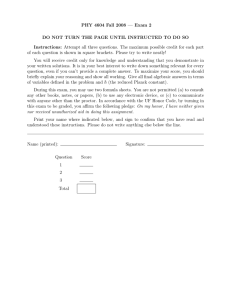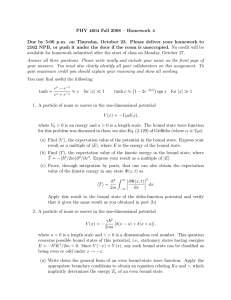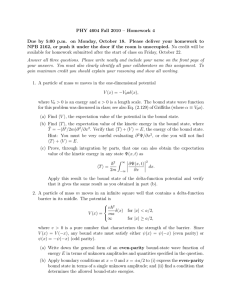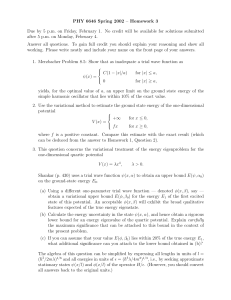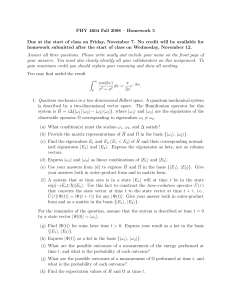PHY 4604 Fall 2009 – Homework 5
advertisement
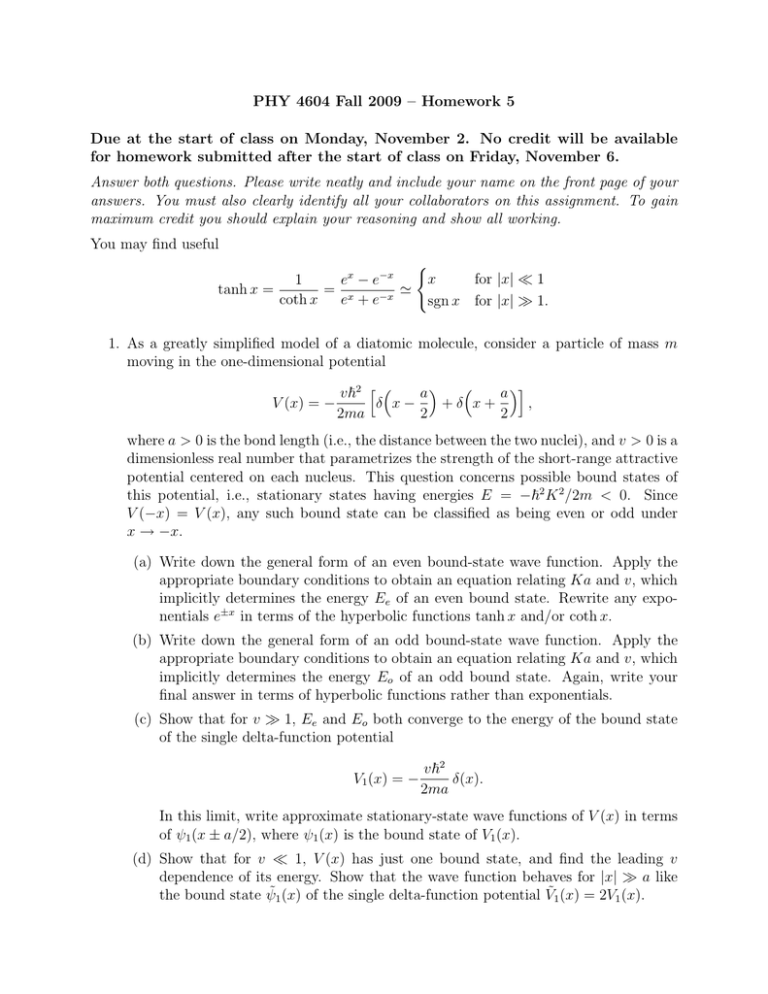
PHY 4604 Fall 2009 – Homework 5
Due at the start of class on Monday, November 2. No credit will be available
for homework submitted after the start of class on Friday, November 6.
Answer both questions. Please write neatly and include your name on the front page of your
answers. You must also clearly identify all your collaborators on this assignment. To gain
maximum credit you should explain your reasoning and show all working.
You may find useful
1
ex − e−x
tanh x =
'
= x
coth x
e + e−x
(
x
for |x| 1
sgn x for |x| 1.
1. As a greatly simplified model of a diatomic molecule, consider a particle of mass m
moving in the one-dimensional potential
v~2 h a
a i
V (x) = −
δ x−
+δ x+
,
2ma
2
2
where a > 0 is the bond length (i.e., the distance between the two nuclei), and v > 0 is a
dimensionless real number that parametrizes the strength of the short-range attractive
potential centered on each nucleus. This question concerns possible bound states of
this potential, i.e., stationary states having energies E = −~2 K 2 /2m < 0. Since
V (−x) = V (x), any such bound state can be classified as being even or odd under
x → −x.
(a) Write down the general form of an even bound-state wave function. Apply the
appropriate boundary conditions to obtain an equation relating Ka and v, which
implicitly determines the energy Ee of an even bound state. Rewrite any exponentials e±x in terms of the hyperbolic functions tanh x and/or coth x.
(b) Write down the general form of an odd bound-state wave function. Apply the
appropriate boundary conditions to obtain an equation relating Ka and v, which
implicitly determines the energy Eo of an odd bound state. Again, write your
final answer in terms of hyperbolic functions rather than exponentials.
(c) Show that for v 1, Ee and Eo both converge to the energy of the bound state
of the single delta-function potential
V1 (x) = −
v~2
δ(x).
2ma
In this limit, write approximate stationary-state wave functions of V (x) in terms
of ψ1 (x ± a/2), where ψ1 (x) is the bound state of V1 (x).
(d) Show that for v 1, V (x) has just one bound state, and find the leading v
dependence of its energy. Show that the wave function behaves for |x| a like
the bound state ψ̃1 (x) of the single delta-function potential Ṽ1 (x) = 2V1 (x).
(e) Find the minimum value v = v2 for which the potential V (x) supports two bound
states. Sketch the form of the bound-state wave functions ψe (x) and ψo (x) for v
just greater than v2 (say, v = 1.1v2 ). Make sure that your graph covers the entire
region |x| < 3a. Label the points x = ±a/2 on the horizontal axis.
(f) Sketch a graph of the bound-state equations that you found in parts (a) and (b).
Your graph should plot Ka along the horizontal axis and v along the vertical axis.
Describe a graphical method for finding the bound state energies, and illustrate
its use (schematically—there is no need to draw a scale plot) for v = 3.
(g) Use a numerical method of your choice—e.g., trial and error substitution into
the equations that you found in parts (a) and (b)—to determine the bound-state
energy (or energies) for v = 3 as a multiple (or multiples) of ~2 /(2ma2 ). Give
your answer (or answers) accurate to three significant figures.
2. Quantum mechanics in a two-dimensional Hilbert space. A quantum mechanical system
is described by a two-dimensional vector space. The Hamiltonian
operator for this
system is Ĥ = ε |ω1 ihω1 | + |ω2 ihω2 | + ∆ |ω1 ihω2 | + |ω2 ihω1 | , where |ω1 i and |ω2 i are
the eigenstates of the observable operator Ω̂ corresponding to eigenvalues ω1 6= ω2 .
(a) What condition(s) must the scalars ω1 , ω2 , and ∆ satisfy?
(b) Provide the matrix representations of Ĥ and Ω̂ in the basis {|ω1 i, |ω2 i}.
(c) Find the eigenvalues E1 and E2 (E1 < E2 ) of Ĥ and their corresponding normalized eigenstates |E1 i and |E2 i. Express the eigenstates as kets, not as column
vectors.
(d) Express |ω1 i and |ω2 i as linear combinations of |E1 i and |E2 i.
(e) Use your answers from (d) to express Ĥ and Ω̂ in the basis {|E1 i, |E2 i}. Give
your answers both in outer-product form and in matrix form.
(f) A system that at time zero is in a state |En i will at time t be in the state
exp(−iEn t/~)|En i. Use this fact to construct the time-evolution operator Û (τ )
that converts the state vector at time t to the state vector at time t + τ , i.e.,
Û (τ )|Ψ(t)i = |Ψ(t + τ )i for any |Ψ(t)i. Give your answer both in outer-product
form and as a matrix in the basis {|E1 i, |E2 i}.
(g) Assume that the system is described at time t = 0 by a state vector |Ψ(0)i = |ω1 i.
Find |Ψ(t)i for some later time t > 0. Express your result as a ket in the basis
{|E1 i, |E2 i}.
(h) Express |Ψ(t)i from the previous part as a ket in the basis {|ω1 i, |ω2 i}.
This question exemplifies the process of changing the basis used to describe vectors in
a Hilbert space. Sections A.4 and A.5 of Griffiths provide a more general discussion of
basis changes using unitary (inner-product-conserving) transformations.
It should be clear from the spectral representation that any Hermitian operator corresponds to a diagonal matrix Ωmn = ωm δm,n when represented in the basis of its own
eigenstates. For this reason, the process of finding the eigenvalues and eigenfunctions
of an operator (or matrix) is often referred to as diagonalizing the operator (or matrix).
